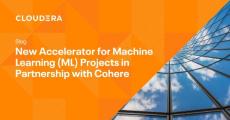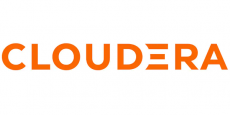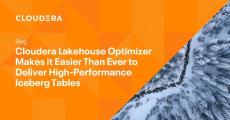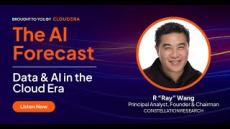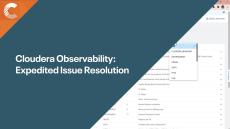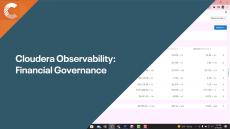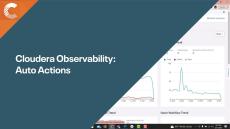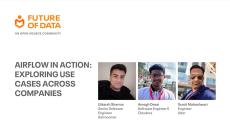|
By Carolyn Duby
Today, cyber defenders face an unprecedented set of challenges as they work to secure and protect their organizations. In fact, according to the Identity Theft Resource Center (ITRC) Annual Data Breach Report, there were 2,365 cyber attacks in 2023 with more than 300 million victims, and a 72% increase in data breaches since 2021. The constant barrage of increasingly sophisticated cyberattacks has left many professionals feeling overwhelmed and burned out.
|
By Jeremiah Morrow
Enterprise organizations collect massive volumes of unstructured data, such as images, handwritten text, documents, and more. They also still capture much of this data through manual processes. The way to leverage this for business insight is to digitize that data. One of the biggest challenges with digitizing the output of these manual processes is transforming this unstructured data into something that can actually deliver actionable insights.
|
By Navita Sood
We are excited to announce the acquisition of Octopai, a leading data lineage and catalog platform that provides data discovery and governance for enterprises to enhance their data-driven decision making. Cloudera’s mission since its inception has been to empower organizations to transform all their data to deliver trusted, valuable, and predictive insights.
|
By Jason Everett
Large Language Models (LLMs) will be at the core of many groundbreaking AI solutions for enterprise organizations. Here are just a few examples of the benefits of using LLMs in the enterprise for both internal and external use cases: Optimize Costs. LLMs deployed as customer-facing chatbots can respond to frequently asked questions and simple queries.
|
By Kevin Talbert
Today we are excited to announce the release of a new Cloudera Accelerator for Machine Learning (ML) Projects (AMP) for PDF document analysis, “Document Analysis with Command R and FAISS”, leveraging Cohere’s Command R Large Language Model (LLM), the Cohere Toolkit for retrieval augmented generation (RAG) applications, and Facebook’s AI Similarity Search (FAISS).
|
By Venkat Rajaji
In August, we wrote about how in a future where distributed data architectures are inevitable, unifying and managing operational and business metadata is critical to successfully maximizing the value of data, analytics, and AI. One of the most important innovations in data management is open table formats, specifically Apache Iceberg, which fundamentally transforms the way data teams manage operational metadata in the data lake.
|
By Meeta Dash
In recent years, machine learning operations (MLOps) have become the standard practice for developing, deploying, and managing machine learning models. MLOps standardizes processes and workflows for faster, scalable, and risk-free model deployment, centralizing model management, automating CI/CD for deployment, providing continuous monitoring, and ensuring governance and release best practices.
|
By Bill Zhang
The open data lakehouse is quickly becoming the standard architecture for unified multifunction analytics on large volumes of data. It combines the flexibility and scalability of data lake storage with the data analytics, data governance, and data management functionality of the data warehouse.
|
By Robert Hryniewicz
We are thrilled to announce the general availability of the Cloudera AI Inference service, powered by NVIDIA NIM microservices, part of the NVIDIA AI Enterprise platform, to accelerate generative AI deployments for enterprises. This service supports a range of optimized AI models, enabling seamless and scalable AI inference.
|
By Jacob Bengtson
The journey from a great idea for a Generative AI use case to deploying it in a production environment often resembles navigating a maze. Every turn presents new challenges—whether it’s technical hurdles, security concerns, or shifting priorities—that can stall progress or even force you to start over.
|
By Cloudera
Companies have access to more data than ever before – according to IDC, worldwide data will grow 61% by 2025. However, when it comes to adopting AI, there is a difference between companies who merely have internal data and those who have precise, accurate data. The first step to delivering trusted AI is having the right type of data. R "Ray" Wang, principal analyst and founder of Constellation Research, joins The AI Forecast to discuss the value of precision data as we enter what he calls “the dark ages of data”.
|
By Cloudera
Hear from guest speaker Adrien Chenailler, Head of Machine Learning at OCBC Digital Bank on his successes using Cloudera.
|
By Cloudera
Managing and forecasting cluster resource consumption costs is a complex task. Inefficient resource allocations and usage can lead to budget overruns and unexpected expenses. The challenge lies in gaining comprehensive insights into your resource consumption across different regions, departments, and user groups. It's also crucial for accurate financial planning. Cloudera Observability provides powerful financial governance capabilities to tackle these challenges effectively by providing unparalleled insight and control over your resource consumption and costs.
|
By Cloudera
Learn how Cloudera Data Visualization uses large language models and retrieval augmented generation to enable faster exploration and analysis of data using natural language.
|
By Cloudera
We have bundled the collective Cloudera support teams, implementation skill and experience into our Observability platform resulting in our framework called validations. This framework offers a clear and detailed view of potential issues within your Cloudera Environment enabling you to fix it internally. Based on years of Cloudera support experience, we identified over 400 and growing issues our customers have encountered frequently, and provide remedies. This framework also provides detailed information to provide to our support team should this issue require a more complex solution.
|
By Cloudera
Managing and forecasting cluster resource consumption costs is a complex task. Inefficient resource allocations and usage can lead to budget overruns and unexpected expenses. The challenge lies in gaining comprehensive insights into your resource consumption across different regions, departments, and user groups. It's also crucial for accurate financial planning. Cloudera Observability provides powerful financial governance capabilities to tackle these challenges effectively by providing unparalleled insight and control over your resource consumption and costs.
|
By Cloudera
Firas Yasin, Global Alliance Manager of AI/ML at RedHat, introduces the RedHat and Cloudera partnership. Firas shares that customers are often missing the combination of security, scalability and support when deploying open-source solutions for their end-to-end data lifecycles. In this video, Firas highlights that together with RedHat OpenShift and Cloudera Data Platform, customers can achieve security and scalability through the joint solution, in addition to catalyzing on RedHat and Cloudera’s unrivaled support offerings.
|
By Cloudera
Cloudera Observability provides the ability to define system rules and automate the appropriate action when those rules are broken through Auto Actions. This prevents for example that any one , query or job monopolizes the system, thereby impacting overall system performance.
|
By Cloudera
Introduction to Apache Airflow: A brief overview for both beginners and enthusiasts. Best Practices and Use Cases: Learn from industry experts about optimizing your workflows and real-world use cases.
|
By Cloudera
Unlock data potential with Cloudera's Open Data Lakehouse powered by Apache Iceberg. Break silos, centralize security, and accelerate AI, BI, and machine learning projects. Collaboration made efficient. Learn more at cloudera.com.
|
By Cloudera
Enterprises require fast, cost-efficient solutions to the familiar challenges of engaging customers, reducing risk, and improving operational excellence to stay competitive. The cloud is playing a key role in accelerating time to benefit from new insights. Managed cloud services that automate provisioning, operation, and patching will be critical for enterprises to leverage the full promise of the cloud when it comes to time to value and agility.
|
By Cloudera
The adoption of cloud computing in the financial services sector has grown substantially in the past three years on a global basis. Diversification of risk is always a key concern for financial institutions and the seeming safety of having a single cloud provider is not being properly measured from a systemic risk and operational risk perspective.
|
By Cloudera
This white paper provides a reference architecture for running Enterprise Data Hub on Oracle Cloud Infrastructure. Topics include installation automation, automated configuration and tuning, and best practices for deployment and topology to support security and high availability.
|
By Cloudera
A cloud-based analytics platform needs to be easy, unified, and enterprise-grade to meet the demands of your business. This white paper covers how Cloudera's machine learning and analytics platform complements popular cloud services like Amazon Web Services (AWS) and Microsoft Azure, and enables customers to organize, process, analyze, and store data at large scale...anywhere.
|
By Cloudera
The Modern Platform for Machine Learning and Analytics Optimized for Cloud.
|
By Cloudera
In the wake of the global financial crisis, the world has become much more interconnected and immensely more complex. As a result, you can no longer simply look at the past as an indicator of future trends. The financial services industry needs real-time insights into numerous interacting variables to make informed decisions.
- November 2024 (9)
- October 2024 (4)
- September 2024 (5)
- August 2024 (6)
- July 2024 (3)
- June 2024 (12)
- May 2024 (9)
- April 2024 (10)
- March 2024 (11)
- February 2024 (14)
- January 2024 (11)
- December 2023 (10)
- November 2023 (14)
- October 2023 (18)
- September 2023 (15)
- August 2023 (10)
- July 2023 (16)
- June 2023 (17)
- May 2023 (13)
- April 2023 (13)
- March 2023 (16)
- February 2023 (6)
- January 2023 (2)
- December 2022 (13)
- November 2022 (9)
- October 2022 (19)
- September 2022 (21)
- August 2022 (20)
- July 2022 (10)
- June 2022 (18)
- May 2022 (9)
- April 2022 (9)
- March 2022 (13)
- February 2022 (13)
- January 2022 (6)
- December 2021 (15)
- November 2021 (18)
- October 2021 (23)
- September 2021 (22)
- August 2021 (26)
- July 2021 (14)
- June 2021 (21)
- May 2021 (24)
- April 2021 (30)
- March 2021 (16)
- February 2021 (19)
- January 2021 (18)
- December 2020 (22)
- November 2020 (17)
- October 2020 (19)
- September 2020 (23)
- August 2020 (27)
- July 2020 (21)
- June 2020 (11)
- May 2020 (22)
- April 2020 (18)
- March 2020 (14)
- February 2020 (8)
- January 2020 (13)
- December 2019 (3)
- November 2019 (1)
- October 2019 (3)
- September 2019 (1)
- August 2019 (2)
- July 2019 (5)
- May 2019 (2)
- April 2019 (1)
- March 2019 (2)
- February 2019 (1)
- January 2019 (3)
- December 2018 (3)
- November 2018 (2)
- September 2018 (7)
- August 2018 (6)
- July 2018 (3)
- June 2018 (3)
- May 2018 (2)
- March 2018 (1)
Cloudera delivers the modern platform for machine learning and analytics optimized for the cloud. Imagine having access to all your data in one platform. The opportunities are endless. We enable you to transform vast amounts of complex data into clear and actionable insights to enhance your business and exceed your expectations.
The right products for the job:
- Enterprise Data Hub: Operate with confidence—thanks to comprehensive security and governance—while at the same time enabling unrivaled self-service performance at extreme scale. All in an enterprise-grade solution that lets you run anywhere, on-premises or in hybrid- and multi-cloud environments.
- Data Science Workbench: Accelerate machine learning from research to production with the secure, self-service enterprise data science platform built for the enterprise.
- Data Warehouse: A modern data warehouse that delivers an enterprise-grade, hybrid cloud solution designed for self-service analytics.
- Data Science & Engineering: Cloudera Data Science provides better access to Apache Hadoop data with familiar and performant tools that address all aspects of modern predictive analytics.
- Altus Cloud: The industry’s first machine learning and analytics cloud platform built with a shared data experience.
The world’s leading organizations choose Cloudera to grow their businesses, improve lives, and advance human achievement.






